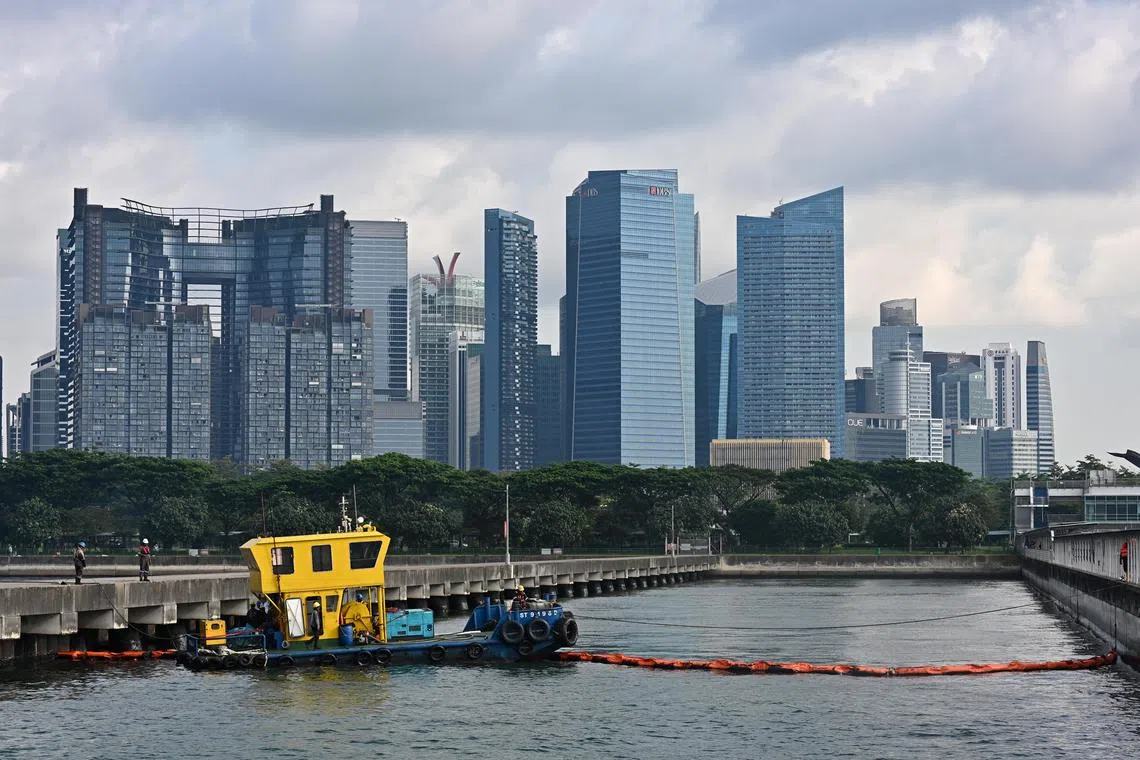Oil skimmers deployed on morning after spill due to difficulty locating oil patches: Chee Hong Tat
Sign up now: Get ST's newsletters delivered to your inbox

A skimmer craft working to clear up oil slicks off Marina South Pier on June 18.
PHOTO: ST FILE
Follow topic:
SINGAPORE – While oil skimmers are the most effective tool against large, thick patches of spilled oil at sea, the Maritime and Port Authority of Singapore (MPA) and its contractors could deploy them only on the morning after the recent oil spill on June 14 as they were hampered by poor visibility.
Transport Minister Chee Hong Tat said it was challenging to first confirm the location of the large oil patches, despite the MPA using a “multi-pronged approach” that included drones, satellite imagery and sightings from ships at sea and personnel on land.
Mr Chee on July 2 set out how the Government responded to the 400-tonne oil spill in a ministerial statement – one of three delivered in Parliament in response to 40 questions from 23 MPs.
He noted that thundery showers on the afternoon of June 14 meant the MPA and its contractors could not spot large oil patches in the first few hours after the allision between the stationary Singapore-flagged bunker vessel Marine Honour and Dutch-flagged dredging vessel Vox Maxima at Pasir Panjang Terminal, which led to the spill.
An allision is an accident between a vessel and a stationary object.
As the density of the spilled oil is very close to that of seawater, the oil slicks may have gone below the water surface, making detection harder, Mr Chee said, adding that the task grew even more difficult when night fell as visibility was reduced.
He said some have asked why MPA did not immediately deploy oil containment booms that were on board its patrol vessel when it arrived at the incident site at 2.33pm, 15 minutes after the incident occurred.
While MPA had activated its contractor T&T Salvage Asia at 2.55pm, it took several hours for the company to mobilise truckloads of gear.
With the night-time conditions and bad weather, T&T finished laying 200m of booms around the damaged Marine Honour at 5.15am on June 15 – nearly 15 hours after the incident.
Mr Chee said the booms on the MPA vessel are lightweight ones that are more suitable for quickly dealing with small-scale, localised spills like oil leakages during bunkering operations.
These lightweight booms were deemed to be unsuitable for dealing with the June 14 spill, which was more serious as it involved the sudden discharge of about 400 tonnes of oil into the sea, he added.
In such cases, the patrol vessel’s role is to spray dispersants to start to break down the spilled oil. Otherwise, the oil will harden over time and become more difficult to remove, Mr Chee said.
He added that the response team on the MPA patrol vessel had followed established procedure correctly, which is in line with international practices.
Asked by Workers’ Party (WP) MP Louis Chua (Sengkang GRC) why the MPA chose to prioritise collecting oil in certain areas before deploying booms to contain the spill, Mr Chee said the authority did not do so.
Responding to Mr Christopher de Souza (Holland-Bukit Timah GRC), Mr Chee said about 4,000m of oil containment booms have been deployed, including absorbent booms with hydrophobic content that can separate oil from water emulsions.
“Our cleanup methods and operations are guided by international experts... and our agencies work closely with specialised companies and contractors which have strong track records in responding to oil spills,” the minister added.
Others, such as WP MP Jamus Lim (Sengkang GRC), asked about the timeliness of the Government’s communications to the public about the spill.
In response, Mr Chee said MPA and other government agencies involved issued five media statements in the first four days to keep the public informed and address their concerns.
These media statements and other updates were also posted on the social media platforms of the respective agencies, he added.
For instance, MPA notified the public of the allision and oil spill through a press release at about 6pm on June 14. At about 9.20pm, the Sentosa Development Corporation (SDC) began to cordon off affected parts of Palawan beach when oil was first spotted there.
The next morning, more oil was seen at Palawan, Siloso and Tanjong beaches at about 7am, and SDC published a Facebook post at 10.59am to inform the public that the waters of these beaches were closed off for cleanup operations.
“Our approach is to push out relevant information to the public as soon as possible, such as information on air and water quality, while we continue with the operations at sea and on land to deal with an evolving situation,” Mr Chee said.
Reiterating points he made during a joint press conference on June 24, the minister said the main purpose of deploying oil containment booms around the damaged bunker vessel was not to “fence in” the oil
He said the booms are also not 100 per cent foolproof, as tidal currents and waves can carry the oil below or above the booms.
Mr Chee said the first phase of the cleanup operations, including those at sea, has been completed.
Meanwhile, an operation to remove about 1,200 tonnes of oil left in Marine Honour’s tanks is ongoing.
On possible measures to prevent future oil spills, Mr Chee said Singapore has taken steps over the years to improve the safety of vessels and bunkering operations here, including drills for crew and vessel inspections in the ports.
“While we do our best to reduce the risks, oil spills may still happen in our waters or in the region. It is not possible to completely eliminate this risk,” he said.
“We will continue to update and improve our SOPs (standard operating procedures) and contingency plan with learning points from this incident, and prepare our teams to deal with oil spills effectively through training and regular inter-agency exercises,” he added.
Several MPs later raised questions about the time it took to deploy containment booms around the damaged bunker vessel, and whether there are ways to reduce this.
Their suggestions included reviewing the processes for storing and mobilising containment booms, and possibly requiring shipping terminals at places like Pasir Panjang to have containment booms within easy reach.
Mr Gerald Giam (Aljunied GRC) noted Mr Chee had said how Singapore responds to oil spills can make a difference to its reputation.
“Does the minister not agree that the earlier the booms are deployed, the better?” he asked.
Mr Chee said the underlying assumption with some of the questions was that MPA’s contractor T&T had been slow and did not do its work properly, which he said was not the case.
Under ideal conditions, it would still take several hours to fully deploy the containment booms, he added. During this time, the oil that has been spilled would already have floated away.
“There is no disagreement with Mr Giam that speed is important and faster is better,” Mr Chee said.
“But I hope Mr Giam understands that even under the best circumstances, some tasks are just not possible. Not practical.”
Mr Liang Eng Hwa (Bukit Panjang) asked if the oil spill would increase costs for Singapore’s shipping and maritime sectors, and have any wider implications on the economy.
Responding, Mr Chee said: “Because our response to the oil spill was swift and effective, I think it didn’t damage our reputation as an international hub port and maritime centre.”


